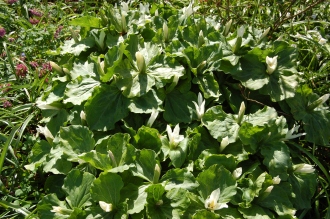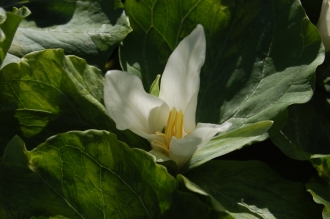Position: Partial shade to shade
Flowering period: Spring
Soil: Moist, well drained
Eventual Height: 40cm
Eventual Spread: 40cm
Hardiness: 6a, 6b, 7a, 7b, 8a, 8b, 9a, 9b, 10a
Family: Melanthiaceae
Trillium chloropetalum is a fast growing, clump forming, herbaceous perennial. Its dark green mottled leaves are obtuse to rounded with and entire margins, appear in groups of three and are up to 20cm long. Its flowers vary greatly in colour from dark red to white, contain three petals, each petal being up to 10cm long. Its roots are thick rhizomes which aids its spread.
Trillium chloropetalum, commonly known as Common Trillium, Giant Trillium, Giant Wake Robin, Wood Lily, Trinity Flower or Sessile Trillium, is native to the west coast of the USA. In its native habitat it grows as a ground cover to the edge of Redwood forests.
The etymological root of the binomial name Trillium is derived from the Latin triplum meaning ‘triple’, referring to the three-parted flowers common to the genus. Chloropetalum may derived from the Latin chlora meaning ’emerald’ and petalum meaning ‘paving’, i.e paved with emerald. Many references state chloropetalum means ‘green petaled’, but I can not substantiate this.
The landscape architect may find Trillium chloropetalum useful as a low growing ground cover plant in shady locations, particularly in woodlands.
Ecologically, Trillium chloropetalum is attractive to pollinating insects. It attracts ants as the elaiosome of the seed will evoke their corpse-carrying behavior, their seeds are also spread by wasps and Harvestmen.
Trillium chloropetalum prefers moist, humus rich fertile, well-drained soils. It prefers an acid to neutral pH of soil.
Trillium chloropetalum requires little maintenance. Large clumps may be divided in late summer to early autumn.







Leave a comment